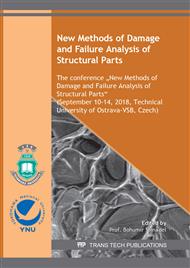[1]
Hutchinson JW. Singular behaviour at the end of a tensile crack in a hardening material. Journal of the Mechanics and Physics of Solids 1968;16:13-31.
DOI: 10.1016/0022-5096(68)90014-8
Google Scholar
[2]
Rice JR, Rosengren GF. Plane strain deformation near a crack tip in a power-law hardening material. Journal of the Mechanics and Physics of Solids 1968;16:1-12.
DOI: 10.1016/0022-5096(68)90013-6
Google Scholar
[3]
Dugdale DS. Yielding of steel sheets containing slits. J.Mech.Phys.Solids 1960;8:100-8.
Google Scholar
[4]
McClintock FA. Plasticity aspects of fracture in fracture an advanced treatise, Edited by H. Liebowitz. Academic Press, New York and London 1971;3:47-225.
Google Scholar
[5]
Rice JR. A path independent integral and the approximate analysis of strain concentration by notches and cracks. Journal of Applied Mechanics 1968;35:379-386.
DOI: 10.1115/1.3601206
Google Scholar
[6]
Cherepanov GP. Crack propagation in continuous media. J. Appl. Math. Mech. 1967;31:503-512. English translation from PMM 1967;31:476-488.
DOI: 10.1016/0021-8928(67)90034-2
Google Scholar
[7]
Neimitz A, Gałkiewicz J, Graba M. Computer program: Name: HRR_par program: Internet address: http://fracture.tu.kielce.pl/index.php?pokaz=hrr.
Google Scholar
[8]
O'Dowd NP, Shih CF. Family of crack-tip fields characterized by a triaxiality parameter – I. Structure of fields. J. Mech. Phys. Solids 1991;39(8):989-1015.
DOI: 10.1016/0022-5096(91)90049-t
Google Scholar
[9]
FITNET: Fitness – for – Service. Fracture – Fatigue – Creep – Corrosion. Edited by. Koçak M, Webster S, Janosch JJ, Ainsworth RA, Koers R. ISBN 978-3-940923-00-4, printed by: GKSS Research Centre Geesthacht (2008).
Google Scholar
[10]
O'Dowd NP. Application of two parameter approaches in elastic-plastic fracture mechanics. Engineering Fracture Mechanics 1985;52(3):445-465.
DOI: 10.1016/0013-7944(95)00033-r
Google Scholar
[11]
Ainsworth RA, O'Dowd NP. Constraint in the failure assessment diagram approach for fracture assessment. ASME J Pressure Vessels Technology 1995;117:260-267.
DOI: 10.1115/1.2842121
Google Scholar
[12]
Neimitz A, Graba M, Gałkiewicz J. An alternative formulation of the Ritchie-Knott-Rice local fracture criterion. Engineering Fracture Mechanics 2017;74(8):1308-1322.
DOI: 10.1016/j.engfracmech.2006.07.015
Google Scholar
[13]
Yang S, Chao YJ, Sutton MA. Higher order asymptotic crack tip in a power–law hardening material. Engineering Fracture Mechanics 1993;45(1):1-20.
DOI: 10.1016/0013-7944(93)90002-a
Google Scholar
[14]
Guo W. Elastoplastic three dimensional crack border field - I. Singular structure of the field. Engineering Fracture Mechanics 1993;46:93-104.
DOI: 10.1016/0013-7944(93)90306-d
Google Scholar
[15]
Neimitz A, Graba M. Analytical-numerical hybrid method to determine the stress field in front of the crack in 3D elastic-plastic structural elements. Proceedings of 17th European Conference on Fracture - Multilevel Approach to Fracture of Materials, Components and Structures, Brno - Czech Republic, 2-5 September 2008, article on CD, abstract - book of abstracts p.85.
Google Scholar
[16]
Neimitz A, Dzioba I. The influence of the out-of-plane and in-plane constraint on fracture toughness of high strength steel in the ductile to brittle transition temperature range. Engineering Fracture Mechanics 2015;147:431-448.
DOI: 10.1016/j.engfracmech.2015.07.017
Google Scholar
[17]
Xiang M, Guo W. Formulation of the stress fields in power law solids ahead of three-dimensional tensile cracks. International Journal of Solids and Structures 2013;50:3067-3088.
DOI: 10.1016/j.ijsolstr.2013.05.011
Google Scholar
[18]
Bai Y., Wierzbicki T., A new model plasticity and fracture with pressure and Lode dependence, International Journal of Plasticity, 24 (2008), 1071-1096.
DOI: 10.1016/j.ijplas.2007.09.004
Google Scholar
[19]
Neimitz A, Gałkiewicz J, Dzioba I. Calibration of constitutive equations under conditions of large strains and stress triaxiality. Archives of Civil and Mechanical Engineering 2018; 18: 1123-1135.
DOI: 10.1016/j.acme.2018.02.013
Google Scholar
[20]
O'Dowd N.P. (1995), Applications of two parameter approaches in elastic-plastic fracture mechanics,, Engineering Fracture Mechanics, Vol. 52, No. 3, 445-465.
DOI: 10.1016/0013-7944(95)00033-r
Google Scholar
[21]
Sherry, A.H., Wilkes M.A., Beardsmore D.W., Lidbury D.P.G., Engineering Fracture Mechanics, 2005,72, str. 2373-2395.
DOI: 10.1016/j.engfracmech.2004.12.009
Google Scholar
[22]
Sherry, A.H., Hooton D.G., Beardsmore D.W., Lidbury D.P.G. Engineering Fracture Mechanics, 2005, 72: 2396-2415.
DOI: 10.1016/j.engfracmech.2004.12.010
Google Scholar


